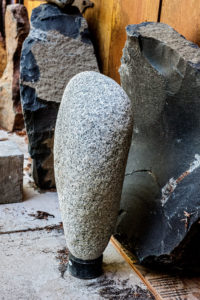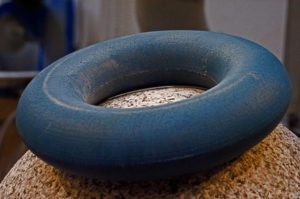The Granite Madonna
in progress.
I hope you
won’t think I’m cheating
to ask for help in a story about
creativity, but I do need help with
something. I need an idea, and as
Bruce Willis said about his own
humanity in The Last Boy
Scout, I’m fresh out
and need your
advice.
Here’s the deal.
See that blue thing
under the sculpture, that keeps
it balanced on the stool? It’s a rubber
grip exercising ring. If you don’t
know what I’m talking about,
check out the closeup
at the end.
I’ve had it
forever. It’s stiff, cracked,
and all gripped out, so I can’t use
it for that anymore. Til a couple of
weeks ago, it sat in a window
gathering dust.
Then I realized that
I could use it to balance unfinished
sculptures while I stand back and study
them or take their pictures.
Here’s what
makes that important.
Many sculptures
of mine rotate effortlessly and
soundlessly on invisible metal bearings.
They are balanced, and they look balanced
all the way around
Given that,
the critical practical issue is
how to position and orient the hole
for mounting the bearing, which sets
the vertical axis of the sculpture
and its axis of
rotation.
♥
If the hole is off
the centre of mass, the
sculpture wobbles as it turns.
If its angle is off, it looks wonky
at all angles and it wobbles.
If a sculpture
should look balanced
but doesn’t, the most likely
explanation is that it isn’t.
Some sculptures
shouldn’t not look balanced,
so we shouldn’t think of them that
way. A great example is Jack Harman’s
bronze depiction of Harry Jerome crossing the
finish line of the 100 metre dash that won a medal
at the 1964 Tokyo Olympics. Never during the
race was Jerome actually balanced, because
he accelerated the whole way. Harman
caught him at the perfect instant,
when he was anything
but balanced.
For a sculpture to rotate
around a vertical axis, no matter its
shape, the hole for its mounting pin must be
vertical. For The Granite Madonna, the first
question was which way should be up.
How to get the hole right was
another problem.

The boulder
rested in my stoneyard
for two winters before I began to
carve it. I looked at it every day, thought
about it, and still took that long to decide
which way was up. As I explained in the
The Granite Madonna video, all three
orientations shown here would
work mechanically.
If the sculpture
is balanced, the forces it takes
to keep it upright under rotation are low.
It can “work” mechanically, esthetically, and
symbolically and evoke similar sets of feelings
in all rotations in all three orientations.
No other orientations
would work.
What made this
a problem is that the exact
same sculpture could work almost
equally effectively in all three ways. All
could rotate. Two would be vertical and
need pins and one could rotate freely
without a pin. With its heavy
end up, the vertical one
would need a stronger
pin and a wider,
heavier base.
But each of
the three could
“work” magnificently.
In What is it
going to be? I discussed
that decision while I was still
doing all I could to avoid making it.
Later, when I took the two side photos,
I dreamed the problem by night
and wondered how to
solve it by
day.
That story is
about my response to a
question about what the piece
would ‘be’ when it was finished.
At the time, it had no title and I
didn’t want one. It wasn’t yet
anything I would yet de-
scribe as anything
approaching
an end.
Names, nouns,
and noun-like descriptors
were the last that I wanted or
needed then, and I avoided
them like the plague.
A little later,
the Granite Madonna still
didn’t have a name, but I had to call
it something. I used a simple, neutral, purely
geometric working title that described what
I was carving without implying more:
Three Surfaces. In To Visualize a
Stone, I describe some of
what I referred to in
that title.
I chose the
vertical orientation with
the heavy end down, and have
been working with it with that way in
mind. I’m not yet committed to an exact
vertical or to the hole in the stone that will fix it.
But it’s time to get serious about that, and
my question here is how to balance
sculptures like this.
Help!
The rock was
70 or 80 pounds when I
took the photos, and round like
an egg on both ends. Though the
ring was a big help to balance
it, it wasn’t easy and it’s
still not balanced
right.
Once it was sort
of balanced, I could walk
away from it a while. But that
particular ring is too small in both
diameters for this particular sculpture.
A bigger, thicker, somewhat softer ring
would ride the rock lower in the ring,
carry weight farther out on the rock
and the ring, which would increase
stability and safety and make
it easier to adjust.
Finding the
vertical takes adjusting the
sculpture as many times as it takes for
it to look right from all directions. Not
just at the moment when I commit
to it with a drill bit, but
forever after.
Everything hinges
on the decision, and in this
case a bigger ring would create
more stable possibilities and make
adjustment faster, safer,
and easier to do.
The blue ring is
a better size for upside down
because the head is smaller than the
bottom. In truth, I need different sizes of
rings for rocks of various curvatures and
weights, but haven’t yet imagined who
might make them or where
to get them.
That’s where
you come in. If you think of
anything that might work, please
let me know. Share this story with any-
one you think might know, so I can
get as many suggestions
as possible.
Note: The
problem has been solved,
at least for now. See
below.
Here are some
things to think
about.
The ring must
be soft enough to conform
itself to the rock and let the rock
sink in a bit, making good contact
all around. But it must be
hard enough not to be
too squishy.
Rocks are heavy.
Once they’re a little off
balance on squishy rings, the
rings would squish more and
more til the sculpture tum-
bled to the ground.
Fluids can’t keep
anything from falling over,
let alone something like a rock,
so balloon-like, waterbed rings
bags full of fluids are out.
While O-rings
come large enough, their
utility as O-rings is in their is
their squishiness, not their
ability to support.
Thanks very much for any help on this.
That article
generated several suggestions,
none of which worked. I sent links
to friends, family, and, colleagues
and got mainly the same
suggestions.
Then my
cousin Dick Paget suggested
a hard rubber component of industrial
butterfly valves that come in various heights
and diameters for a range of valves. My four
diameters are nearly perfect for my needs.
AND I still have and still use the
same blue ring!
Before I carved
Flowering, the boulder I carved
it in weathered winters of storms and
winds on a small valve fitting, patiently,
while I worked up courage to start
carving it. The finished sculpture,
below, is on its mounting pin.


With regard to
the sculpture of Harry Jerome
the sprinter, Architects of their Own
Education offers a fascinating comparison
between sprints and all other distances
of world-class competitive racing.
The book Rodin on
Art has a fascinating account of the
problem of portraying movement in solid
media like stone and bronze. It has everything to
do with how balances and imbalances within
designs play out, in the experience of
observers over time.
According to
Rodin, sculptors make
movement by guiding viewers’
attention through time, from earlier
in a scenario sequentially to later,
when the sculpture points
into the future.
First published in the Vancouver Observer.
Edited March 2021




One thought on “Help!”